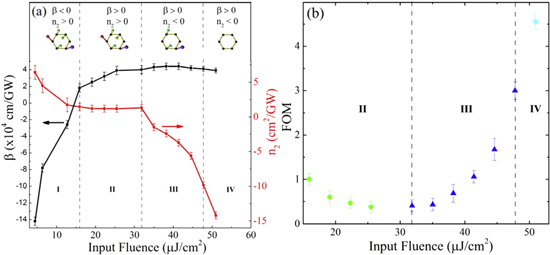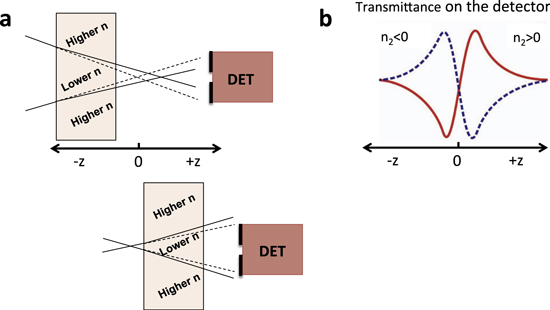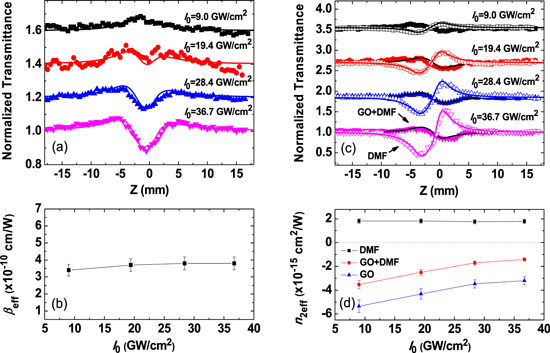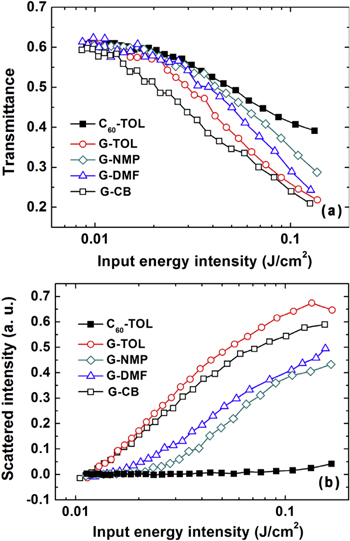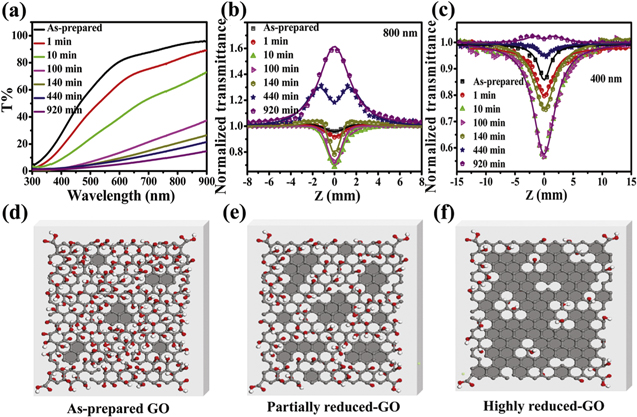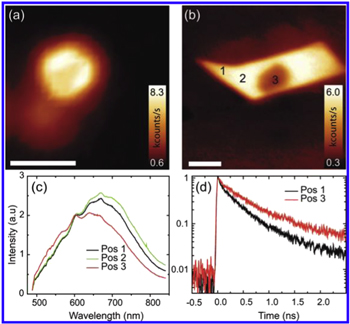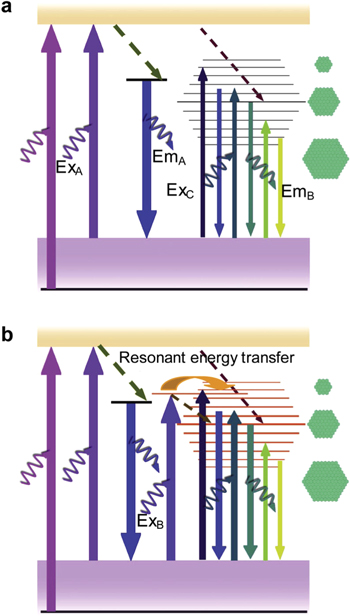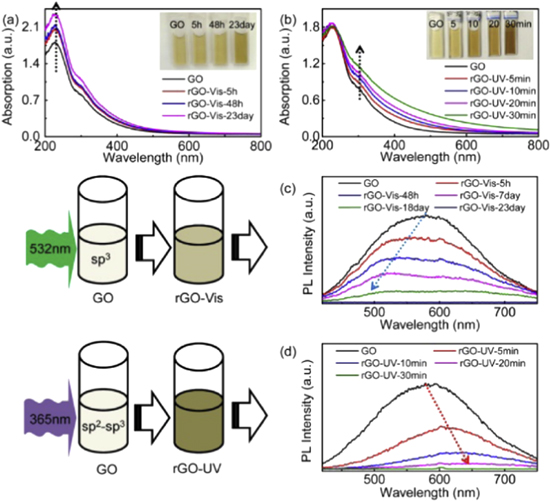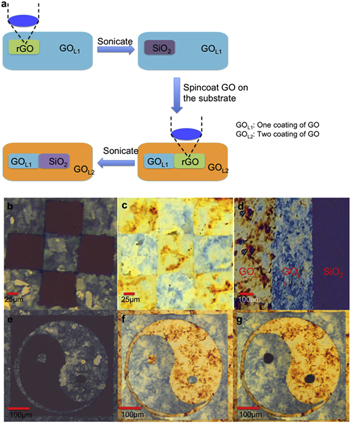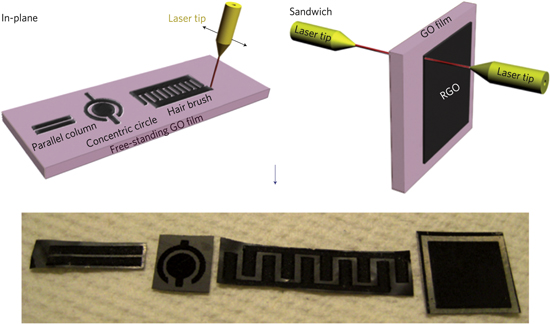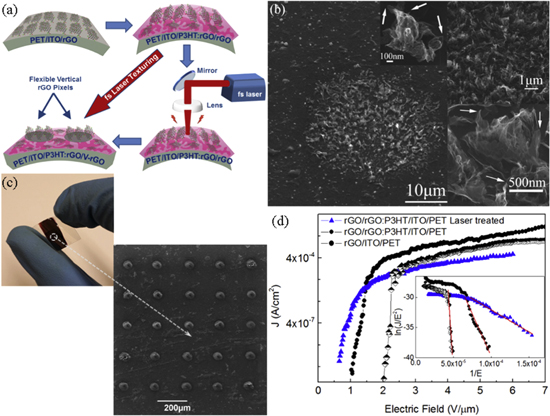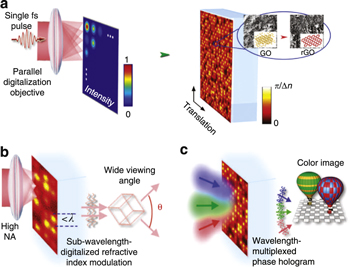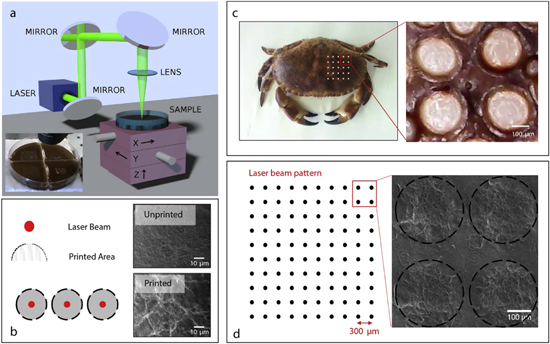Abstract
The successful exfoliation of graphite has initiated new science in many research fields and is employing a huge number of scientists in the world investigating the chemical, structural, mechanical and optoelectrical properties of the atomic-thick sheets of graphene and graphene oxide (GO). Similarly to other carbon-based materials, the graphene family have shown exceptional optical responses and nowadays it is engineered to produce efficient photonic components. In this review, we aim to summarize the main results in nonlinear optical response and fluorescence of GO. Moreover, its laser printing is reviewed as a novel promising lithographic technique.
Export citation and abstract BibTeX RIS
Introduction
The first production of graphene oxide (GO) dates back to 1859 by Oxford chemist Brodie [1] and the synthesized 'paper-like foils' with micro-metric thickness have been mainly of interest to chemists and later to material scientists involved in the fabrication and characterization of carbon-based substances. The recent and amazing discovery of graphene in 2004 has redirected researchers' interest in GO and now the huge scientific production about GO and its properties has started to be comparable to that of graphene.
GO is produced more easily than graphene by the exfoliation of the bulk material graphite oxide dispersed in basic solutions. Graphite oxide is a compound of carbon, hydrogen and oxygen in variable ratios, given by treating graphite with strong oxidizers. The so obtained oxidized bulk product retains the layer structure of graphite but with a much more irregular and larger spacing. Mainly two methods for the synthesis of GO are proposed: the pioneering Brodie method consists of treating graphite with potassium chlorate and fuming nitric acid [1] and the Hummer method [2, 3]: the synthesis is done in inert containers using highly pure reactants and solvents to obtain largest monolayer GO with highly intact carbon framework and minimal residual impurity concentrations. This last process, developed in 1957 by Hummers and Offeman, with some modifications, is quicker, safer and more efficient. The degree of oxidation and synthesis method are crucial in determining the properties of GO; for example, a difference of the temperature point of explosive exfoliation up to 100° for the two methods has been shown and hydration and solvation properties of Brodie and Hummers graphite oxides are known to be remarkably different [4].
Thanks to the facile and successful production processes in the last decade, GO has been used in several very diverse fields. First of all, GO has attracted great interest as a possible route for the large-scale production and manipulation of graphene, an atomic layer material with extraordinary electronic properties and one of the most investigated substances both from academics and industries with huge investments. The reason for this enormous success lies in the fact that graphene is a zero band gap (semi-metal) material and considered one of the strongest and flexible material ever tested, with optimal heat and electric conductivity. Differently from graphene, GO is an insulator, almost a semiconductor, with differential conductivity between 1 and 5 × 10−3 S cm−1 at a bias voltage of 10 V [5]. The chemical reduction of these foils yields a suspension of graphene flakes, limited in quality by the used GO specifications and the efficiency of the reducing agent [6]. Recently, the mobility values of charge carriers exceeds 1000 cm2 V–1 s–1 for the best quality of graphene flakes. However, the graphene obtained by GO reduction still has many chemical and structural defects; a problem for some applications but an advantage for some others.
Nowadays, owing to the GO unique characteristics, interest among scientists from various disciplines has increasingly shifted from GO as a precursor of graphene to the properties of GO itself. GO is flexible and single layer like graphene, but form graphene differently and thanks to the presence of the oxide groups is water-soluble, bio-compatible and friendly to many different materials. For this, it can be easily integrated and included as active component in liquid, gel and solid structures with several and many diverse applications ranging from water desalinization and purification, impermeable barrier films, protective coatings paint and strong papers production, DNA analysis, plastic electronics and flexible rechargeable battery electrode [7–12]. Moreover, recently GO has also attracted much attention as an antibacterial agent. It has been shown that the sharp edges of GO interfere with the physiological activity of bacteria and can disrupt the membrane of bacteria [13–16]. Scientists observed the strong antimicrobial properties of GO against a wide variety of both gram-positive and -negative bacterial pathogens, bio film forming microorganisms and phytopathogens [17–19]. For these exceptional characteristics, GO is nowadays also proposed for tissue engineering [20, 21].
An additional extraordinary characteristic of GO is the manipulation of the shape, size and relative fraction of the sp2 and sp3 hybridized domains of GO by reduction chemistry; a powerful way to tune its bandgap and therefore controllably transform GO from an insulator to a semiconductor and to a graphene-like semi-metal [22]. One very recent application of GO reduction is the generation of THz radiation once pumped by femtosecond near-infrared laser. THz emission has been enhanced by increasing the reduction degree and decreasing the film thickness [23]. The chemical reduction, moreover, allows tunable nonlinear optical response and is at the basis of GO laser printing, a novel technique with several and various applications, as illustrated in the following sections.
Furthermore, in contrast to pure graphene, GO is fluorescent over a broad range of wavelengths, owing to its heterogeneous electronic structure. These exceptional attitudes and light affinity make GO an excellent candidate for novel optical materials, biosensing, solar cells and photonic devices [24–30]. GO based photodetectors have been also proposed [31]. In this work, the fast photoresponse from the fully suspended reduced GO and the thin thickness of film, provides an original way for fast response GO-based device.
Other very peculiar characteristics of GO are its extraordinary flexibility and the possibility of being dispersible as single layers in various matrices. The mechanical properties are crucial for the fabrication of flexible electronic and photonic devices [32] and liquid crystals of GO mono-layers have been proposed since 2010; a nice review is given in [33]. Thanks to the water dispersibility, GO colloidal flakes show spontaneous nematic assembly. Full color reflection and fine control of the quality and pitch of the GO photonic crystallinity, given by the nanoscopic tailoring of the electrostatic thickness and macroscopic variation of the curvature, have been shown very recently [34]. GO liquid crystal has been used successfully as rewritable media for reflective displays without polarizing optics [35].
A scheme of the unique and exceptional characteristics of GO together with the related advantages and applications in photonics and fundamental optics is illustrated in figure 1.
Figure 1. A scheme of the main and unique characteristics of GO and the related advantages and proposed applications in brackets.
Download figure:
Standard image High-resolution imageIn this review, we highlight the recent advances in optical properties and photonics of GO.
We would like to point out that most of the huge production in literature on this topic, including those reported above, regards the fundamental optical properties of GO and its conceptual usage in photonic devices. Only very recently, GO was proposed in true applications as passive laser component, light source or detector and holographic display, as we will mention below.
In the following, we report recent and most significant investigations in nonlinear optics (NLO), emission and fluorescence characteristics, super cavitation and laser printing.
Nonlinear optics
Optical nonlinearities are of great importance for high performance all-optical photonic devices [36, 37]. There is significant interest in manipulating the intensity and shape of laser pulses in a number of advanced optical technologies using NLO materials and to this aim both nonlinear absorption (NLA) and nonlinear refraction (NLR) of GO have been extensively investigated.
In these works, NLR has been mainly ascribed to the Kerr effect, which causes phase variations of the electromagnetic field traveling inside the sample, leading as a final observable effect to the self-focusing of the transmitted beam intensity.
Nonlinear absorption is a phenomenon defined as a nonlinear change (increase or decrease) in absorption with increasing pumping intensity. This can be of either two types: saturable absorption (SA) and reverse saturable absorption (RSA). With increasing injected intensity, if the excited states show saturation owing to their long lifetimes, the transmission will show SA characteristics. If, however, the excited state has strong absorption compared with that of the ground state, the transmission will show RSA characteristics. Saturable absorbers display an increased transmittance at high input laser intensity and are useful for pulse compression, Q-switching and mode locking, while reverse saturable absorbers (or optical limiting materials) display decreased transmittance at high input laser intensity and can be used to protect eyes and sensitive instruments from laser induced damage. RSA is observed as a result of excited-state absorption (ESA) and two photon absorption (TPA), that arise from the extended π-conjugate system typical of the chemistry of carbon based materials [38–42].
Both nonlinear mechanisms, at the basis of photonic applications, have been investigated widely in carbon-based materials and recently in the graphene family. For this, we dedicate the next section to the most relevant reported results about GO optical nonlinearities and we then show in a separate section the recent applications of such findings in photonic devices.
Nonlinear refraction and absorption of GO
In the last decade, many authors considered graphene optical nonlinearities, i.e. saturable absorption for laser mode-locking and Kerr effect for all-optical switching [43–46] and nowadays growing attention is given to its functionalized insulating analogue GO [27, 47, 48]. In this section, we aim to review and discuss nonlinearities in GO (solution and thin film) and its composites. Large attention and effort is addressed to considerable variations in NLO parameters during the chemical reduction of GO. Such a unique property of GO is becoming crucial in the investigation of optical nonlinearities in carbon based materials and makes GO an excellent candidate as a versatile photonics component.
The research on GO nonlinear properties is largely limited to the NLA and only few works report nonlinear refraction. Among them, [37] reports on the in situ nonlinear activities of GO films during their laser-induced reduction process by continuously increasing the pumping irradiance until the optical breakdown. As shown in figure 2(a), four stages of different nonlinear activities have been discovered with increased laser fluence. Both the tuning of the nonlinear absorption response and a switch of the sign for the nonlinear refractive index are observed during the transition from GO to reduced-Go (rGO). Moreover, giant Kerr nonlinear responses are observed leading to a giant nonlinear figure of merit (FOM) crucial for the design of functional nonlinear devices (figure 2(b)). Various nonlinear mechanisms are proposed as being responsible for the observed nonlinear activities including the ground state bleaching of the sp2 domain, two-photon absorption and excited state absorption of the sp3 matrix, and the population redistribution.
Figure 2. (a) Plot of nonlinear refractive index n2 and nonlinear absorption coefficient β versus the input laser fluences. Four different stages (IIV) of nonlinear activities as well as the atomic structure of GO film are identified. (b) Nonlinear FOM in stages II–IV. [37] John Wiley & Sons. Copyright Clearance Center 2014.
Download figure:
Standard image High-resolution imageZhang et al [49] illustrated the NLR properties of GO in N, N-dimethylformamide (DMF) in nanosecond, picosecond and femtosecond time regimes by Z-scan, a sensitive single-beam technique introduced in 90' [50] and extensively used in the quantitative investigation of optical nonlinearities.
In Z-scan experiments, the transmittance of a sample is measured through a finite aperture in the far field as the sample is moved along the propagation direction z of a focused Gaussian beam. The sign and magnitude of the nonlinear refraction and absorption are easily deduced from such a transmittance curve (Z-scan). For major clarity and for non-experts, a sketch is printed in figure 3. In figure 3(a), a material with a negative nonlinear refractive index, n2 < 0, moves along z direction. Starting the scan from a distance far away from the focus (negative z), the beam irradiance is low and negligible nonlinear refraction occurs; thus the transmittance (dashed curve in figure 3(b)) remains relatively constant. As the sample is brought closer to focus, the beam diverges in near-field due to the defocusing effect and narrows in far-field at the aperture which results in an increase of the transmittance on the detector DET. As the scan in z continues and the sample goes to the right side of the focal plane (positive z), the same self-defocusing broadens the beam at the aperture, and consequently decreases the transmittance on the detector. At the focal plane, a minimal change of the far-field pattern of the beam is obtained due to the absence of beam divergence. The Z-scan is completed as the sample is moved away from focus (positive z) such that the transmittance becomes linear since the injected light intensity is again low. In the case of self-focusing materials with n2 > 0, following the same analogy, an opposite valley-peak configuration is obtained with an opposite sign of the transmitted curve versus z (solid curve in figure 3(b)). The sensitivity to nonlinear refraction is entirely due to the aperture, and removal of the aperture completely eliminates the effect.
Figure 3. A scheme of the closed-aperture Z-scan experiment for n2 measurement. (a) Moving the nonlinear sample through the focus (z = 0) of a lens the aperture of the transmitted beam on the detector DET changes leading to the transmitted curve shown in (b). Dashed line is the beam direction without sample, solid line is the deviation in presence of the nonlinear sample. The example in (a) is for n2 < 0 (defocusing) materials. (b) Transmitted curves versus z for negative (dashed curve) and positive (solid curve) n2.
Download figure:
Standard image High-resolution imageTo measure nonlinear absorption and estimate the NLA coefficient β the same scheme with open aperture is used. In this way, whole transmittance is measured by the detector and the traces are symmetric with respect to the focus (z = 0) where they have a minimum transmittance (e.g. in case of multiphoton absorption) or maximum transmittance (e.g. in case of saturation of absorption).
The results of NLA by using Z-scan measurements reported in 4-a from [49] show the switch from SA to RSA and the nonlinear refraction curves depicted in 4-c demonstrate negative NLR properties in nanosecond time regime, which is mainly attributed to transient thermal effect in the dispersion. The dispersion also exhibits negative NLR in picosecond and femtosecond time regimes, which are arising from sp2- hybridized carbon domains and sp3- hybridized matrix in GO sheets. The Z-scan curves are analyzed by means of the theory first described in [50] and based on the propagation of Gaussian beams after phase modulation due to refraction modulation n(z) = n0 + n2I(z), with n0 the linear and n2 the nonlinear refractive index and I(z) the input intensity profile. The beam propagates inside the nonlinear sample and at the exit the phase and the amplitude are so varied, after further propagation of such distorted radiation beam from the sample to the aperture (far field) the transmittance T(z) can be calculated analytically and in case of small beam divergence the following final simple expression is obtained:

with x = z/z0 and  the on-axis phase shift at the focus, z0 is the diffraction length of the beam, k is the wave vector,
the on-axis phase shift at the focus, z0 is the diffraction length of the beam, k is the wave vector,  the effective length, L the sample length, and α0 the linear absorption coefficient.
the effective length, L the sample length, and α0 the linear absorption coefficient.
An exact theory for Gaussian phase profiles and for the on-axis approximation has been also proposed [51]. This model is based on the propagation of a wave front by means of the Fresnel diffraction integral and the Huygens–Fresnel principle. The final expression is

where

and Γ is the well known incomplete gamma function and d the propagation length from the sample to the aperture.
In most works in the literature, expressions (1) and (2) are used to analyze the experimental nonlinear refraction variations.
For the nonlinear absorption and open aperture Z-scan measurements, the final form of the transmission results

where

Equations (4) and (5) are used to evaluate the nonlinear absorption coefficient β.
In case of the coexistence of both saturable absorption and reverse saturable absorption, the following expression for the absorption coefficient is used:

where the first term is responsible of SA with IS the saturation intensity and the second one indicates RSA.
In [49], the Z-scan curves are fitted by means of equations (1) and (4) as shown in figures 4(a) and (c) and the energy trends of the so obtained fitting parameters nonlinear refraction index n2 and nonlinear absorption coefficient β are depicted in figures 4(b) and (d). The pure solvent show positive refractive nonlinearity, differently from GO.
Figure 4. For 35 ps pulse at 532 nm. (a) Open-aperture Z-scan curves of the dispersion of GO in DMF (GO + DMF). (c) NLR Z-scan curves of the dispersion of GO in DMF (GO + DMF) and DMF, solid icons are related to the dispersion (GO + DMF), hollow icons stand for the solvent of DMF. Solid lines are theoretical fits. (b) Effective TPA coefficient βeff of GO as a function of incident intensity. (d) Effective NLR coefficient n2eff of DMF, the dispersion and GO sheets as functions of incident intensity. Reproduced with permission from [49]. © 2013 Optical Society of America.
Download figure:
Standard image High-resolution imageMany diverse GO hybrid materials with excellent NL optical properties have been proposed. For example, the nonlinear refraction and optical limiting properties of GO coordinated with Fe3O4 nanoparticles (GOFe3O4) were studied by Z-scan technique at 532 nm in the nanosecond and picosecond regimes [52]. Results show that GOFe3O4 exhibits enhanced NLO and optical limiting properties in comparison with the pristine GO in the nanosecond regime.
Both the nonlinear absorption and refraction of low-loss hybrid GO-gold nanoparticles (GO-AuNP) films were demonstrated to be enhanced monotonically with the increase of AuNP concentration by Z-scan measurement, as shown in [53]. The observed strong nonlinear light–matter interactions of the hybrid GO-AuNP films were attributed to the efficient energy and/or charge (electron) transfer upon photoexcitation, and the synergistic coupling effects between GO and AuNPs.
Recently, giant third-order nonlinear response has been obtained in electrochemically derived graphene oxide (EGO) film [54]. The oxidation degree of the EGO materials is controlled by manipulating the oxygen functional groups on the basal plane. The third-order nonlinearities of the prepared EGO films have been investigated using the Z-scan technique, indicating both strong nonlinear absorption and nonlinear refraction, as demonstrated also by the nice curves reported in figure 5. Most importantly, the excellent stability and repeatability of the prepared EGO films under high-power laser illuminations has been demonstrated and attributed to the lower oxidation degree, the abundant epoxy groups and less hydroxyl groups compared to the chemically derived GO.
Figure 5. (a) Open aperture Z-scan results (scatters) of the EGO film under four increasing input fluences. The theoretical fittings are indicated as the solid lines. (b) Close aperture Z-scan results (scatters) of the EGO film under four input laser energy intensities. The theoretical fittings are plotted as the solid lines. Reprinted from [54], with the permission of AIP Publishing (2016).
Download figure:
Standard image High-resolution imageThese results provide promising potential for the low-loss and highly efficient high power nonlinear applications.
In addition to the fabricated solid thin structures, GO in a liquid state has also been widely considered and the dependence of the optical limiting properties of dispersions of single layer graphene in several solvents have been reported [55, 56]. Light scattering measurements showed that such nonlinearity is mainly due to nonlinear scattering from solvent micro bubbles. Graphene flakes absorb the incident laser radiation and heat the surrounding solvent resulting in the formation of gas bubbles. When the bubbles reach the size of light wavelength, they scatter the incident beam yielding considerable reduction of transmission. Alternatively, the graphene flakes can be ionized by the high intensity laser pulses forming microplasmas that act as scattering centers. In these works, NLA has been demonstrated by doing transmission measurements and by estimating the transmittance damping for growing input energy, as shown in figure 6.
Figure 6. Input energy intensity dependence of (a) nonlinear transmittance and (b) nonlinear scattered light intensity for single-layer graphene dispersed in toluene (TOL-red circles), N-methyl-2-pyrrolidinone (NMP-cyan diamonds), N,N-dimethyl-formamide (DMF-blue triangles), and chlorobenzene (CB-black squares), respectively. The solid squares in (a) and (b) indicate the nonlinear transmittance and scattered light intensity for C60-toluene solution. Reprinted with permission from [55]. © 2014 Optical Society of America.
Download figure:
Standard image High-resolution imageThe optical limiting properties of graphene and GO sheets in aqueous and organic solvents with different polarities and viscosities and in polymeric gel matrix have been widely investigated [57]. The authors attributed the observed broad band non linearity to two photon absorption and the TPA coefficients have been obtained and compared to those of C60 and carbon black suspensions. Transmittance limiting for aqueous solutions of graphene sheets (GS) and GO is evident from the measured transmission data with the fitting curves, as shown in figure 7.
Figure 7. Limiting comparison of aqueous suspensions of GS and GO for 532 nm at top and 730 nm at bottom. Redline: fitting with regards to the TPA mechanism model. Reprinted with permission from [57]. Copyright 2010 American Chemical Society.
Download figure:
Standard image High-resolution imageNonlinear scattering and two-photon-absorption were found to have strong effects on the NLO and optical limiting responses of aqueous suspensions of different graphene nanostructures, including graphene oxide nanosheets (GONSs), graphene nanosheets (GNSs), graphene oxide nanoribbons (GONRs), and graphene nanoribbons (GNRs) [58]. GNSs, GONRs, and GNRs exhibited broadband nonlinear absorption properties at 532 and 1064nm wavelengths and with nanosecond pulsed laser. Z-scan measurements tested stronger NLA responses in reduced graphene samples than in their GO precursors because of the increased crystallinity and conjugation. Moreover, the variation of the normalized transmittance as a function of the pumping energy intensity for the above mentioned dispersions has been shown (figure 8).
Figure 8. Variation in the normalized transmittance as a function of the input energy intensity for dispersions of different graphene nanostructures at 532 nm (a) and 1064 nm (b). Reprinted from [58], with the permission of AIP Publishing (2010).
Download figure:
Standard image High-resolution imageIn 2009, interesting Z-scan measurements at 532 nm of NLO properties of GO dispersions were demonstrated TPA in picosecond pulsed regimes and ESA at nanosecond pulses [59]. The authors compared the optical nonlinearities of three carbon nanomaterials, 0D fullerene, 1D carbon nanotube (CNB), and 2D graphene and they claim that the nonlinear mechanism of GO is distinctly different from nonlinear scattering of carbon nanotube and excited state nonlinearity of fullerene. The nice results are reported in figure 9. Equations (4), (5) and (6) are used to fit the Z-scan data. In this work, a first demonstration of the switch from saturable to reverse saturable absorption at high energies has been clearly evidenced.
Figure 9. (Left) Open aperture Z-scan curves of GO in DMF at different intensities. Solid lines represent theoretical fits obtained using equations (4) (5) and (6). I0 is on-axis peak intensity at focus. (Right) NLA coefficient β as a function of input intensities for nanosecond and picosecond pulses. Reprinted from [59], with the permission from AIP Publishing (2009).
Download figure:
Standard image High-resolution imageA similar investigation has been proposed by Liaros et al [60], reporting important nonlinear optical response, both in the visible and in the infrared, under both nanosecond and picosecond laser pulses in aqueous suspensions of finely dispersed large sheets of GO. Moreover, the switch from saturable to reverse saturable absorption at high energies has been clearly evidenced together with the distinct nonlinear behavior of GO in comparison with fullerenes. In the theoretical analysis of this work, the multiphoton absorption processes have been taken into account. Specifically, instead of equation (6), a four-photon absorption was used, as

Recently the effect of the degree of chemical reduction on the microstructure of GO suspensions and optical nonlinearity has been investigated [22]. The linear and nonlinear optical properties of both GO as well as the reduced graphene oxides (rGO) have been measured by single beam Z-scan measurements in the picosecond region. The results, depicted in figure 10, reveal both saturable absorption and two-photon absorption, strongly dependent on the intensity of the pumping laser: saturable absorption occurs at lower pump pulse intensity whereas two-photon absorption dominates at higher intensities. The authors found that the two-photon absorption coefficient and the saturation intensity vary with chemical reduction due to the varying concentrations of sp2 domains and sp2 clusters in the reduced graphene oxides.
Figure 10. Open aperture Z-scan curves of GO and RGO samples measured at different pulse energy. Reproduced with permission from [22]. © 2014 Optical Society of America.
Download figure:
Standard image High-resolution imageLaser-induced reduction of GO thin films on glass and plastic substrates resulted in enhancement of effective two-photon absorption coefficient at 400 nm by up to ∼19 times and enhancement of effective two- and three-photon absorption coefficients at 800 nm by ∼12 and ∼14.5 times, respectively [36]. The as-prepared GO films were found to exhibit strong broadband optical-limiting behaviors, which were significantly enhanced upon partial reduction by using laser irradiation or chemical reduction methods. A significative illustration of the experiments and results is shown in figure 11, where the inversion of the NLA response sign is evident.
Figure 11. Linear transmittance (a) and Z-scan measurement results at 800 nm (b) at 400 nm (c) of a GO film upon exposure to hydrazine vapor for different periods of time. (d)–(f) Schematic structures of GO at different stages of reduction: as-prepared (d), partially reduced (e), and highly reduced (f). Reprinted with permission from [36]. Copyright 2012 American Chemical Society.
Download figure:
Standard image High-resolution imageThe deep investigation of the optical nonlinearity in dependence of the degree of reduction is relevant for the realization of GO-based photonic components, i.e. passive mode lockers and/or Q-switchers in fast pulsed high energy lasers, as reviewed in the next section.
Photonic applications of optical nonlinearities
A few years after its discovery, graphene has been proposed and widely used asa saturable absorber in mode-locking lasers thanks to the exceptional SA properties and flexibility [61–64]. Differently, GO has shown weak saturable absorption as reported above and this, in comparison to graphene, limits its application as a photonic component. However, some authors have succeeded in using the solvent dispersibility and the chemical reduction and manipulation of GO to obtain GO-based passive mode lockers. To our knowledge, the first demonstration was given by Song et al in 2010 [65]; in this work, the authors used GO as precursor of graphene that is prepared by hydrazine hydrate/NH3 reduction of GO and neutralized by dialysis. The obtained homogeneous water dispersion was sprayed onto the flat surface of a side-polished single mode fiber. The suspension droplets were carefully dried as they hit the polished surface and form a uniform film of graphene. The mode locking component realized by the evanescent field interaction between the propagating light and graphene layer was used for 1.3 ps pulse generation with 0.01 nm spectral resolution.
Later, a nanosecond-pulse erbium-doped fiber laser has been realized with passive mode locker given by a hollow-core photonic crystal (HC-PCF) fiber filled with few-layered graphene oxide (FGO) solution [66]. FGO (4–5 layers) was synthesized by arc-discharge method using a buffer gas containing carbon dioxide and dispersed in common organic solvents. The observed saturable absorption in GO is attributed to the presence of pristine graphene nanoislands with sp2-hybridized carbon atoms, that is much higher in FGO than in conventional GO. The strong SA is given by faster energy relaxation of hot carriers, combined with good dispersion capability and arising from the large fraction of sp2 domains together with oxidation mainly existing at the edge areas. FGO was dispersed in N;N -dimethylmethanamide (DMF) and then was filled into the core of HC-PCF through a selective hole filling process to obtain the mode locking component of the ns-pulsed fiber laser. The characteristics of the laser is depicted in figure 12.
Figure 12. Characteristics of the mode-locked pulses. (a) Laser pulse train. (b) Output pulse spectrum, centered at 1 561.2 nm. (c) Pulse shape (black line) with sech2 fit (red line). (d) Emission power versus pump power. (e) RF spectrum with fundamental repetition rate of 7.68 MHz. (f) RF spectrum measured around the tenth harmonic of the repletion rate at 76.8 MHz. The red traces in (e) and (f) depict the background when the laser is switched off. Reproduced with permission from [66]. © 2011 Optical Society of America.
Download figure:
Standard image High-resolution imageAn innovative way, named a single filling step, to obtain GO film for mode locking in fiber lasers was shown in 2017 [67]. With this process, based on the quick evaporation of the liquid host of a GO suspension with a hot finger, the authors were able to coat capillaries and microstructured fibers with GO. This sophisticated drying method produces a continuous GO film firmly attached to the capillary walls along the whole length of the capillaries. The GO was then reduced into rGO after thermal treatment under nitrogen flow. As an application, microstructured fibers coated with GO and rGO were then optically characterized and used as a passive mode locker in fiber laser cavities with ns pulse duration and spectral few nm spectral line. Moreover, it has been shown that rGO films provide lower propagation losses and better laser performances.
Femtosecond pulsed fiber laser with ring cavity configuration and self-assembled graphene oxide saturable absorber mirror (GOSAM) as passive mode locker have been fabricated [68]. In this work, the authors immerse a broadband reflective mirror into GO hydrosol for 48 h to successfully obtain a thin GO membrane on the broadband reflective mirror. By controlling the net cavity dispersion, a 200 fs pulse duration with 22.9 MHz repetition rate has been gained as shown in figure 13, together with the sketch of the laser setup.
Figure 13. (Left) Schematic setup of the graphene oxide mode-locked erbium-doped fiber laser. (Right) Characteristics of GO mode-locked fiber laser in near zero dispersion cavity: (a) stable pulse train at 22.9 MHz repetition rate. (b) Optical spectrum. (c) 200 fs pulse width. (d) Frequency spectrum. Reproduced with permission from [68]. © 2012 Optical Society of America.
Download figure:
Standard image High-resolution imageA similar kind of application has been proposed in [69], where a GO/polyvinyl alcohol (GO/PVA) film has been fabricated and used as a saturable absorber in short pulsed Er-, Yb-, and Tm-doped fiber ring lasers. Broad range mode-locking in the 1 and 1.5 μm regions has been obtained by simply inserting the thin GO film inside the ring cavity.
Compared to bulk lasers, mode-locked fiber lasers are known to have limited performance particularly in terms of pulse energy, duration and often also quality. The reasons for the efforts in fabricating mode-locked fiber lasers lie in the advantages: compact design, low cost, broad band emission, high gain efficiency and compatibility with telecom components. In realizing such innovative lasers, the passive mode-locking mechanisms are mainly external semiconductor saturable absorber mirrors, nonlinear amplifying loop mirrors and nonlinear polarization rotations. The use of GO that simply can be sprayed or dispersed inside the fibers is a powerful tool to obtain low cost ultrafast fiber lasers. The technique of obtaining efficient SA still has to be optimized and most of the proposed lasers have ps-hundreds of fs pulse duration and low mean power.
Only recently, Gao et al used rGO to yield a mode locked Watt-level, all-fiber, ultrafast Er/Yb-codoped double-clad fiber laser [70]. The rGO solution was filled into the cladding holes of PCF, and after evaporation, the rGO flakes interact with a light intensity of only 1/107 of that in the center of PCF. This ultraweakly interacting structure has been shown to enhance the thermal damage threshold and decrease the accumulated nonlinearity and thus to be extremely suitable for high-power mode-locked laser. By incorporating the saturable absorber into an Er/Yb-codoped fiber ring cavity, stable soliton laser with femtosecond duration was generated, and with increasing pumping, harmonic mode-locking was given. The maximum average power of 1.14 W has been obtained.
The first usage of GO as a saturable absorber in the passive mode-locking of a diode pumped laser has been reported by Liu et al [71]. Sub-10 ps mode-locking in a Tm:YAlO3 (Tm:YAP) laser near 2 μm was obtained by using GO deposited on hydrophilic quartz substrate instead of more expensive and complex semiconductor SA mirrors. A stable mode-locking pulsed laser with the average power of 268 mW, repetition rate and corresponding pulse energy of 71.8 MHz and 3.7 nJ, respectively, was fabricated. Such performance is a bit lower than that of the bulk lasers commercially in use, but the costs are much lower and the technology is improving fast.
The non linear absorption of graphene and GO has been also used for Q-switching lasers to obtain very high power pulsed laser. Graphene has been inserted in a erbium-doped fiber laser in 2010 [72] and since this pioneering publication, many research groups have proposed several applications.
The water dispersibility and consequent strong deposition efficiency of GO have been utilized by Wang et al to fabricate a novel and low-cost GO absorber [73]. Vertical evaporation technique was used to make polyvinylalcohol (PVA)-GO film that was inserted between a quartz substrate and an output coupler mirror, the sandwich structure was then used as SA component in the Q-switched Nd:GdVO4 laser with 1.22 W average output power and 2 μJ pulse energy.
Afterwards, GO has been functionalized in different ways to be used as saturable absorber for Q-switching. For example, a high-energy Q-switched double-clad thulium-doped fiber laser (TDFL) has been demonstrated using for the first time a graphene-oxide-deposited tapered fiber (GODTF) device as a saturable absorber, operating at a wavelength of 2 μm and with single pulse energy of 6.71 μJ [74]. In this work, a droplet of GO solution was dripped onto the taper waist region of a single mode fiber and heated by a laser.
In another work, a quartz thin substrate was immersed in a suitably prepared GO solution and a stable solid passive SA has been obtained and successfully used for ps pulsed Q-switched mode-locked dual-wavelength Nd:GYSGG laser with average output power of 189 mW [75].
Very interestingly, liquid GO has also been proposed as a Q-switcher in [76], where for the first time a dispersion of GO in heavy water was used as absorber in Q-switched Nd:YAG laser. The shortest pulse duration of the Q-switched laser is 523 ns and the maximum peak power is 6.6 W. The proposed liquid absorber has the advantage of good optical transparency, high heat dissipation and no contact damage.
GO is going to be a good candidate as saturable absorber in solid state Q-switched lasers thanks to its very low cost and its dispersibility in various flexible matrices. However, high energy and low repetition rates have not yet been gained with GO and intense research is ongoing in such direction.
Fluorescence
While graphene does not have an energy band gap, and, for this, fluorescence should not be possible unless assisted by phonons, in GO, a bandgap is opened thanks to the oxidation. The bandgap renders GO interesting and with relevant optical properties.
The heterogeneous atomic and electronic structures of GO and rGO is responsible of light emission with notable and unexpected consequences and important applications, e.g. in biological systems [27, 77, 78].
GO exhibits photoluminescence (PL) in a wide electromagnetic frequency range from near infrared (NIR) to ultraviolet and PL in GO is much stronger than that of graphene. There are mainly two PL bands for GO, one in the blue region (blue band) and another in the range of 500–650 nm (long wavelength, or LW band).
A visible example of bright emission is reported in figure 14, with nice confocal PL images and relative emission spectra of the broad luminescence (500–800 nm) from GO obtained by oxygen plasma-treating of mechanically exfoliate single-layer graphene [79].
Figure 14. (a) Confocal PL image excited at 473 nm for a graphene sample oxidized for 3 s. Scale bar 5 μm. The bright PL spots are spatially localized. (b) Uniform emission after 5 s. Scale bar 10 μm. (c) Spectra detected at the positions marked in (b) corrected for detector response. These have broad PL centered at 700 nm. (d) PL transients detected at the positions indicated in (b). Reprinted with permission from [79]. Copyright 2009 American Chemical Society.
Download figure:
Standard image High-resolution imageIn comparison to organic compounds, the PL spectrum of GO is complicated due to the presence of various domains and different functional groups. The PL bands have not been well understood, and their origin has been controversial and still under investigation.
Luo et al [80] suggested a dispersion of hard gaps, which may arise from bond alternation within the GO plane giving rise to inter-valley scattering, an illustration is given in figure 15. The authors in this work reported broadband visible photoluminescence from solid GO and modifications of the emission spectrum by progressive chemical reduction.
Figure 15. Normalized PL excitation-emission maps for solid GO taken in transmission during hydrazine vapor exposure. Reprinted from [80], with the permission of AIP Publishing (2009).
Download figure:
Standard image High-resolution imageBlue fluorescence with a relatively narrow bandwidth when excited with UV radiation has also been detected from chemically reduced GO (rGO) and the PL intensity has been correlated to the evolution of sp2 domains during reduction [81].
Recently, a comprehensive picture of the photoluminescence mechanism at about 430 nm of different chemically derived GOs has been given during the reduction process of GO [82], a scheme is depicted in figure 16 and a more detailed explanation of tunable PL mechanisms during GO reduction is reported by Chien et al [77] and summarized in figure 17. In this work, the tunable PL spectra of GO during reduction have been ascribed to the variation of the relative intensity ratios of PL emission from two different types of electronically excited states, as a result of changing the heterogeneous electronic structures of GO and rGO with variable sp2 and sp3 hybridization domains.
Figure 16. Schematic illustration of the PL emission mechanism. The emission is composed of two parts, defect state (left side) and the localized energy levels caused by the size effect of sp2 clusters (right side). (a) For rGO, the blue emission from the defect state is predominant (the wide arrow). (b) For functionalized rGO, the explanation of the enhanced PL is presented. A new excitation process appears and the excitation of sp2 clusters themselves is also improved by resonant energy transfer. [82] John Wiley & Sons. Copyright Clearance Center 2013.
Download figure:
Standard image High-resolution imageFigure 17. PL emission mechanisms of (a) the predominant intensity emission in GO from disorder-induced localized states. (b) The predominant intensity emission in rGO from confined cluster states. [77] John Wiley & Sons. Copyright Clearance Center 2012.
Download figure:
Standard image High-resolution imageIn [83], time-resolved fluorescence measurements of GO in water show multiexponential decay kinetics ranging from 1 ps to 2 ns. The authors proposed as the origin of the fluorescence the electron-hole recombination from the bottom of the conduction band and nearby localized states to wide-range valance band. The relative intensity changes of few emission species causes the excitation wavelength dependence of the fluorescence. The authors, by using the molecular orbital concept, claim that the dominant fluorescence originates from the electronic transitions among/between the non-oxidized carbon regions and the boundary of oxidized carbon atom regions. A significative illustration of the proposed model is shown in figure 18.
Figure 18. (a) Top view and side view of GO model; (b) electronic band structure and density of states (DOS) of GO; (c) schematic of fluorescence excitation and emission of GO; (d) quasi-molecular orbital energy levels of GO; (e) fluorescence related orbitals of GO. Reprinted by permission from Macmillan Publishers Ltd: Scientific Reports [83]. Copyright (2012).
Download figure:
Standard image High-resolution imageThe dependence of the PL spectrum of GO on the pH and concentration of GO aqueous solutions has been reported in [84]. It was discovered that PL in the visible range becomes prominent when the pH value is low and/or the GO concentration is high. Time-resolved photoluminescence reveal that the lifetime of the PL in the visible range is longer than that in the UV range. These results evidence the formation of excimers and prove that the PL band at the long wavelength is caused by the GO excimers.
A different strategy to obtain efficient PL has been proposed by Chen et al [85], who reported a method to promote photoluminescence emission in graphene materials by enhancing carrier scattering instead of directly modifying band structure in multilayer reduced graphene oxide (rGO) nanospheres. The authors intentionally curl graphene layers to form nanospheres by reducing graphene oxide with spherical polymer templates to manipulate the carrier scattering. These nanospheres produce hot-carrier luminescence with a more than ten-fold improvement of emission efficiency as compared to planar nanosheets.
Very recently, GO excitation wavelength dependent fluorescence, known as giant red-edge effect, controlled by strain has been demonstrated [86]. Such a giant red-edge effect originates in a local reorganization potential, slowing down the solvation dynamics of the excited state to the same time scale as the fluorescence lifetime. The present work has discovered that out-of-plane strain in the GO sheet leads to the intra-layer interaction necessary to slow down the solvation time scale. The authors show that the shift of the emission wavelength with increasing excitation wavelength can be tuned by controlling the strain (as depicted in the schematics in figure 19) and the electronegativity of a suitable dopant.
Figure 19. Schematic explanation of how out-of-plane strain controls the red-edge effect. (a)–(c) Without strain, the excited dipole does not feel intra-layer reorganization potentials, and fluorescence is independent of the excitation wavelength. (d)–(f) With strain, after excitation the relaxation of the excited state dipole moment is slowed down to the same time scale as the fluorescence by intra-layer interactions, resulting in excitation wavelength dependent fluorescence. Reproduced from [86] with permission of The Royal Society of Chemistry.
Download figure:
Standard image High-resolution imageIn 2017, Yue et al have investigated the fluorescence evolution processes of visible/ultraviolet photo-reduced graphene by steady-state photoluminescence and femtosecond transient absorption spectroscopy [87]. They demonstrated that both absorption and luminescence of GO change drastically if the photo-reduction is obtained with UV or visible radiation, as shown in figure 20.
Figure 20. Steady-state absorption spectra of GO and rGOs reduced by (a) visible light and (b) UV light with different reduction time. The insets of (a) and (b) show the corresponding photographs of GO and rGOs reduced by visible light and UV light, respectively. Steady-state photoluminescence spectra (excited by 400 nm) of GO and rGOs reduced by (c) visible light and (d) UV light with different reduction time. The left panels of (c) and (d) is the schematic diagram of visible/UV photo-reduced GO. Reproduced with permission from [87]. © 2017 Optical Society of America.
Download figure:
Standard image High-resolution imageA relevant photonic application of GO photoluminescence has been reported in [88]: low-energy fluorescence in red to NIR wavelengths (600–1100 nm) has been detected for suspensions of nano-sized synthesized GO and PL from visible through infrared range was used for cellular imaging. Anticancer drugs were loaded onto the nano-GO sheets and selectively transported into specific cancer cells by antibody guided targeting.
Another amazing application has been proposed in 2015 [89]. In this article, Wang et al observe electroluminescence (EL) in suitably semi-reduced GO-based devices. By using a laser-scribing method, they induce on the GO surface the formation of a series of rGO nanoclusters with many different sizes, able to single-colour emit by controlling the doping level of each realized pixel. The origin of such EL has been ascribed to the recombination of Poole–Frenkel emission ionized electrons at the localized energy levels arising from semi-reduced GO, and holes from the top of the π band. The light-emission spectrum is, in this way, in situ adjusted from blue (450 nm) to red (750 nm) by electrical gating or environmental doping. Within this research, the authors present current-driven tunable single light-emitting diode (LED) with applications in high-quality displays. The scheme of the proposed graphene-based field effect LED (GFLED) and emission from the GFLED on a flexible polyethylene terephthalate (PET) substrate are illustrated in figure 21.
Figure 21. (Left) Sketch of the GFLED. Light emission is provided by distinct semi-reduced GO (blue) at the interface between GO (orange) and rGO (gold). Right: bright red light emission from the GFLED on a flexible polyethylene terephthalate (PET) substrate. A 12V bias voltage and a 0.1A drive current are applied. The GFLED size is around 100 × 100 mm. The edge of the bent PET is marked by a dashed line and the bending radius is about 8 mm. Reprinted by permission from Macmillan Publishers Ltd: Nature Communcations [89]. Copyright (2015).
Download figure:
Standard image High-resolution imageCompared to commercial FLEDs, the efficiency of this GO-based device is still low (25%) mainly due to the lost of supplied power caused by heat dissipation. Moreover, the emission lifetime of these devices are tens of seconds in ambient conditions and only under vacuum stable emission up to 2 h can be obtained.
Laser printing and supercavitation
Another important chapter in the photonics of GO is its laser printing. Recently, the wide diffusion of high power short pulsed lasers and atomic force microscopy (AFM) promoted the development of a non- lithographic method based on direct writing to pattern graphene/GO sheets. Inject printing has been also proposed as an alternative tool for the line patterning of GO foils [90–93].
Laser writing is a powerful tool for the micropatterning of graphene sheets, a promising novel research field and a successful technology with great potential in various applications such as transparent electrodes, field effect transistors, biosensors and energy devices.
Surface modification of thin films by focused laser beam has been an important technological achievement [94] and the basics of this technique is the creation of patterned heat zones by the focused laser beam which induces a localized physical state transition. Sufficiently high laser power provokes ablation of materials such as ceramics, steel, nanostructures, and biological samples like human tooth [95, 96].
The laser texturing of GO is mainly based on the laser induced reduction of GO and its supercavitation, a thermal nonlinear optical effect. Compared with lithographic procedures [97], the direct writing method provides an easy and practical way to produce micropatterned graphene/GO foils, the main advantage, in addition to reliability, scalability and low cost, is that such a method does not require the masking of the resist steps.
In this section, we review some of the main results in laser printing of GO and some application as photonic device.
In [98], a focused laser beam is employed to construct an extended area of micro-patterned GO and reduced GO multilayers on quartz substrates in a fast and controlled manner. The laser writing arises from the oxidative burning of the GO films in air. Thick films adsorb sufficient thermal energy to reach the evaporation temperature required to form rGO stripes. A representative illustration is shown in figure 22. The authors proposed such a technique, based on the laser reduction of the GO to graphene, as a successful method to create graphene channels excavated in the matrix of insulating GO.
Figure 22. Schematic illustration of the creation of microfeatures on GO nanosheets with an optical microscope-focused laser beam. [98] John Wiley & Sons. Copyright Clearance Center 2010.
Download figure:
Standard image High-resolution imageIn addition to thin films, three dimensional composites obtained by laser writing have been also considered. As an example, 3D GO-reduced GO (rGO) stacked-layered structures with predefined micropatterns in each layer were obtained by using a multi-step versatile technique described in [99]. The main novelty proposed is that the micropatterns are defined in each layer with hierarchical control through a method involving irradiation of focused laser beam on GO deposited on SiO2/Si substrate. A schematic diagram of 3D printing method and well defined patterns are shown in figure 23.
Figure 23. (a) Schematic diagram for 3D patterning of GO. Positive development is used to develop the 3D patterns. (b) Checkered boxes after removing the scanned region through sonication. The sample was then spin coated with GO again to obtain (c), where the yellowish region denotes a thicker GO region and the light blue region denotes a thinner GO region. (d) 'Staircase' like structure with two coatings of GO. AFM measurements show that each step was about 65–70 nm. (e) Taiji logo with one coating of GO (f) two coating of GO. (g) Two circular dots inside the logo are being removed through sonication after scanning with focus laser beam. Reprinted from [99], with the permission of AIP Publishing (2012).
Download figure:
Standard image High-resolution imageThe laser texturing technique has been used to develop versatile devices in different fields: from electronics and photonics to biomedicine.
In 2011, Gao et al used the ability to laser reduce GO into conducting reduced graphite oxide (rGO) for the realization of rGO-GO-rGO patterns in various configurations and the fabrication of electrical double-layer capacitors (EDLC) or supercapacitors [100]. In EDLCs, the only source of ions is the hydrated GO in the patterned regions and the electrical energy storage is achieved at the interface between the reduced and non-reduced sections (the electrode and electrolyte). A scheme of GO laser patterning and fabricated chips are illustrated in figure 24. The measured capacitance depends on the design of the device, as the ionic mobilities and transport distances vary for different geometries. The highest capacitance is 0.51 mF cm−2, in the same range as for other similar systems without external electrolyte. Moreover, the proposed devices show good energy storage capacities and cyclic stability comparable to existing thin film supercapacitors.
Figure 24. Schematics of CO2 laser-patterning of free-standing hydrated GO films to fabricate rGO-GO-rGO devices with in-plane and sandwich geometries. The black contrast in the top schematics corresponds to rGO, and the light contrast to unmodified hydrated GO. For in-plane devices, three different geometries were used, and the concentric circular pattern gives the highest capacitance density. The bottom row shows photographs of patterned films. Reprinted by permission from Macmillan Publishers Ltd: Nature Nanotechnology [100]. Copyright (2011).
Download figure:
Standard image High-resolution imageFlexible organic electronic devices have been reported by Viskadouros et al [101]. The authors present a methodology to fabricate highly efficient flexible graphene-based field emission cathodes by drop-casting rGO on composite rGO:P3HT polymer layers and subsequent direct laser writing. Laser radiation causes a pronounced vertical alignment of rGO bundles perpendicular to the substrate and at the same time sharp graphene edges are protruding out of the bundle. Such a complex structure increases field enhancement up to factor 8900 and the so obtained laser fabricated devices exhibit a very low turn-on field of 0.6 V μm–1, which is the best reported for rGO FE cathodes to date. In addition, the cathodes exhibit stable and excellent robustness under intense and repetitive bending. The results are illustrated in figure 25 together with a schematic picture of the fabrication procedure and significative images.
Figure 25. (a) Schematics of the methodology used for the fabrication of vertical rGO field emission pixels; (b) field emission scanning electron microscopy (FESEM) views of a single pixel obtained by laser induced texturing of the top rGO layer. The insets depict typical views of the morphology of the textured rGO areas, while the arrows indicate sharp graphene edges exposed due to laser; (c) optical and FESEM view of a flexible vertical rGO cathode, each pixel consists of vertically oriented rGO sheets; (d) field emission (FE) measurements. Reprinted from [101], with the permission from AIP Publishing (2014).
Download figure:
Standard image High-resolution imageOne nice and recent photonic device based on printed GO is a bolometer, which requires high absorbance capacity, structural stability and efficient convertion of optical signals into electrical signals [102]. The authors realize an absorptive coating by simply pouring GO solution on the surface for further drying and using laser microstructuring to control change of the material properties in certain defined spots. The alternation of rGO and GO domains allows us to put together remarkably high values of rGO conductivity and GO resistance to obtain efficient prototypes of bolometer. Schematics of the device and measurements are shown in figure 26. The proposed systems display temperature coefficient of resistance (TCR) values lower than some widely used bolometric composites, while the obtained absorption values of more than 98% in the visible and more than 90% in the infrared range are unique.
Figure 26. (a) Sample preparation process. (b) Measurement scheme of complete and spectral reflection of the samples. (c) Installation procedure and contact diagram when measuring thermal properties. Reprinted with permission from [102]. Copyright 2016 American Chemical Society.
Download figure:
Standard image High-resolution imageIn 2015, flexible and versatile GO ultrathin (200 nm) flat lenses were realized [103]. The effective manipulation of the phase and amplitude of an incident beam simultaneously provides far-field three-dimensional subwavelength focusing with 32% absolute focusing efficiency in 400–1500 nm wavelength range, more than 30 times improvement in comparison with the state-of-the-art ultrathin flat lenses. Moreover, the full width half maximum (FWHM) in the lateral and axial directions are measured to be 577 nm and 1.56 mm, respectively, outperforming most of the ultrathin lenses operating under single wavelength radiation. This is the first realization of a subwavelength-scale flat lens able to focus white light in three-dimension with minimal chromatic aberration, in addition to mechanically robustness and excellent focusing properties under high stress. Design and characterization of the GO-lens is shown in figure 27.
Figure 27. (a) Conceptual design and laser-writing fabrication of the GO ultrathin lens. (b) Amplitude and phase modulations provided by the transmission and refractive index difference, respectively, between the GO and rGO sections. (c) Topographic profile of the GO lens measured with an optical profiler. (d) (Left) Schematic of the wavefront manipulation by the GO lens converting the incident plane wave into a spherical wavefront. (Right) Intensity distributions of the 3D focal spot predicted by the analytical model for a GO lens. (e)–(h) Theoretical (e), (f) and experimental (g), (h) focal intensity distributions in the lateral and axial directions. Reprinted by permission from Macmillan Publishers Ltd: Nature Communcations [103]. Copyright (2015).
Download figure:
Standard image High-resolution imageFine laser patterning of GO films has been utilized successfully for the realization of a holographic display. This is achieved by the subwavelength-scale multilevel modulation of optical refractive index in reduced graphene oxides under single femtosecond pulsed beam. The authors were able to reduce the pixel size to 0.55 μm obtaining a viewing angle up to 52°. Commercially available liquid crystal-based spatial light modulator (SLM) have minimum pixel size of 3–4 μm with lowest viewing angle of 3–5 degrees. In addition, the spectrally flat optical index modulation enables wavelength-multiplexed holograms for full-colour images. A nice demonstration of static three-dimensional holographic images is depicted in figure 28.
Figure 28. (a) Schematic illustration of the optical digitalization of refractive-index/phase modulation. (b) Scheme of wide-angle 3D images by confining the photoreduction at a subwavelength scale by incrementing the NA of the parallel digitalization objective. (c) Reconstruction of color objects through the wavelength-multiplexed phase hologram recorded in GO polymers. Reprinted by permission from Macmillan Publishers Ltd: Nature Communcations [104]. Copyright (2015).
Download figure:
Standard image High-resolution imageThe same group investigated giant refractive-index modulation by two-photon reduction of fluorescent GO-polymers by fs pulsed laser beam [105]. The large phase modulation with the simultaneous fluorescence control was proposed for multimode optical recording with enhanced information security and capacity. The proposed mechanism is schematically illustrated in figure 29.
Figure 29. (a) GO-polymer sample obtained by mixing GOs with PVA solutions. (b) Illustration of giant refractive-index modulation induced by two-photon reduction and the simultaneous fluorescence intensity by a fs beam. (c) Multimode optical recording by laterally translating the sample across the focal plane and controlling the strength of the two-photon reduction. Reprinted by permission from Macmillan Publishers Ltd: Scientific Reports [105]. Copyright (2013).
Download figure:
Standard image High-resolution imageIn 2016, a novel method for GO laser patterning based on a nonlinear optical effect, named supercavitation [106], was proposed by Papi et al [107]. The authors in this work entrap GO in a gelified material (agar) and shape it by using supercavitation as optimized GO printing procedure.
Optical supercavitation occurs during the propagation of nonlinear optical waves in an arrested state dense absorbing fluid. It can be obtained for instance by focalizing a laser beam in a light absorbing gelified medium. When this happens, a shock-wave front in the material occurs forming a depletion region of the absorbing molecules. The process resembles cavitation and supercavitation hydrodynamic phenomena. The shock-depleted region has vanishing concentration of material and this allows light propagation through the otherwise solid-like and absorbing medium. Such a phenomenon occurs in the very same way that a shock-induced gaseous region favors propulsion in liquid supercavitation.
In the work by Papi et al, a high-power laser pulses locally ablates the GO-gel, exposing GO nanosheets cast in the polymer. The authors in this way demonstrate an antibacterial cloak realized by laser printing GO hydrogels mimicking the Cancer Pagurus carapace and they observe up to 90% reduction of bacteria cells. Schematics of the innovative laser printing method are shown in figure 30.
Figure 30. (a) Experimental setup for the laser printing of the surface of the agar substrates. (Inset) Patterned GO-agar substrate by focusing a 5 mJ laser pulse. (b) On the left, sketch of the laser pulse action as occurs on the GO-based substrate: the red bullets represent the point interested by the laser pulse, the gray area is subject to the cavitation induced by the thermal expansion of the GO-Agar. The panels on the right show SEM images of the unprinted (top) and printed (bottom) area of the substrate. (c) Cancer Pagurus (left) and detail of the carapace pattern (right). (d) Sketch of the geometry of the optically realized patterns (left) and SEM images (right). Reprinted by permission from Macmillan Publishers Ltd: Scientific Reports [107]. Copyright (2016).
Download figure:
Standard image High-resolution imageThe feasibility of laser-driven simultaneous reduction and pattern generation on GO surfaces has been used for the local induction of osteogenesis and deposition of bone matrix by stem cells [20].
Conclusions
Since its discovery, the richness of optical and electronic properties of graphene have attracted enormous interest. Graphene has high carrier mobility and optical transparency, besides flexibility, robustness and environmental stability. In addition to its fundamental physics and electronic characteristics, its true potential lies in photonics and optoelectronics. Indeed, even though a single atom thick, it can be optically visualized. Its transmittance can be expressed in terms of the fine-structure constant. The linear dispersion of the Dirac electrons allows broadband applications and saturable absorption is observed as a consequence of Pauli blocking; moreover, non-equilibrium dynamics of hot carriers result in detectable luminescence [63].
The chemically derived GO is an atomically thin sheet of graphite and has traditionally been thought and served as a precursor for graphene, but nowadays is considered an excellent bio compatible component with exceptional optomechanical properties useful in various fields of research. Indeed, it has oxygen-containing functional groups, both at the edges or on the basal plane, so that it contains a mixture of sp2- and sp3-hybridized carbon atoms. In particular, thanks to its chemical reduction, manipulation of the size, shape and relative fraction of the sp2-hybridized domains of GO provides a unique and versatile tool for tailoring its optoelectronic properties. Furthermore, in contrast to pure graphene, GO is fluorescent over a broad range of wavelengths, owing to its heterogeneous electronic structure. For these reasons, GO has also been successfully proposed as a photonic component for several usages.
The aim of this review is to summarize the most relevant achievements in nonlinear optics, fluorescence and laser printing. We mentioned very few results about graphene photonics, to which other reviews are dedicated. We focused our attention on GO, that, itself, can be considered without doubt as a low cost one dimensional material with unique optoelectronic properties and great versatility, due to the possibility of chemical manipulation, water dispersibility and biological affinity.
GO in different matter states, liquid, solid and gel, dispersed in solvents with variable pH, polarity and density and in various amorphous polymeric matrices with finely controllable thickness showed important nonlinear optical responses that can be easily tuned and switched to manipulate shape and intensity of laser light. The very diverse systems proposed by research groups in all over the world presented nonlinear absorption with variable sign, both saturable absorption (useful for mode locking and pulse compression in last generation lasers) and reverse saturable absorption (useful for limiting optical damage) have been demonstrated. Different mechanisms, from fast multiple photon and excited state absorption and Kerr effect to impurity and bubble scattering, have been indicated as responsible of such nonlinearities. We described some applications of the discussed optical nonlinearity in short pulsed high power lasers.
Moreover, we tried to briefly review the important results regarding GO emission and the different physical mechanisms that cause it. Many authors have reported bright and broadband emission from several compounds, which can be successfully tuned by chemical reduction and variable strain. Diverse GO compounds have been proposed as biosensors and several applications, where sensible fluorescence is required, have been achieved.
The wide use of lab-on-chip and miniaturized components for applications, ranging from bio-medicine to electro-optics and solar cells, encouraged many researchers to develop alternative matter patterning with very controllable and precise shapes and dimensions. Laser printing of GO films is one of the last modern techniques proposed in the last few decades and we wanted to review the main results, being that laser printing is nowadays considered an emerging and very promising branch of photonics. In this review, we reported some illustrations that demonstrate the high potentially of this novel lithographic technique.
In conclusion, the background of strong optical responses of carbon-based materials and the discovery of graphene family have fueled the development of a novel branch of photonics. GO is now widely investigated both for optical applications and fundamental physics thanks to the strong and versatile light–matter interaction, basement of condensed matter physics and photonics.
We acknowledge financial support from the Sapienza Ateneo, PRIN2015 NEMO project (2015KEZNYM Grant), the H2020 QuantERA project QUOMPLEX (Grant No. 731473), the PRIN 2017 PELM project, the H2020 Grant No. 820392 and the project Joint Bilateral Scientic Cooperation CNR (Italy)/RFBR (Russia) 2018-2020.



